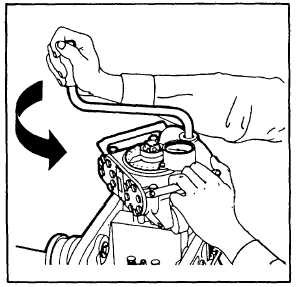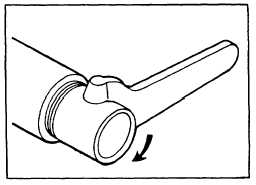TM 9-243
USING THE POWER TORQUE WRENCH - Continued
8
After obtaining the desired torque, turn the crank in
the opposite direction until the torque indicator
returns to zero (green band). This will remove the
holding pressure on the wrench.
9 Remove the wrench, adapter, and socket.
10
To loosen a nut, repeat steps 1 through 6.
NOTE
Normally, torque will build up in the
wrench until break-away torque is
reached. As the torque load is
released, the indicator will reverse
direction.
11
Continue to turn crank until indicator returns to "O."
12
Remove the wrench, adapter, drive bar and socket.
USING A SPANNER WRENCH
1
Insert the pins or lugs into the pin holes of the part.
2
Keep the pin face of the wrench flush against the
surface and turn the wrench.
3 Exert enough force against the wrench so that the
pins do not pop out of the holes.
4 Make certain that the pins fit the holes and the force
is applied with the handle perpendicular to the work.
5 Remove the wrench when desired tightness is
obtained.
CARE
1
Clean all wrenches after each use.
2
Wrenches that come in sets should be returned to
their cases after use.
2.1 Store torque wrenches as follows:
a. When
storing
the
micrometer-type
torque
wrenches or beam-type torque wrenches, check
to make sure they are returned to zero before
storing.
b. For the rest of the torque wrenches (unless your
local SOP states differently) zero them before
you store them. This takes the pressure off the
spring, and the wrenches will last longer and
give better service.
3 Apply a thin film of oil to the metal parts of all
wrenches before storing them. Remove oil before
use to prevent injury or damage.
4 For long-term storage, the wrenches should be
covered with a rust-preventive compound and
carefully stored in a dry place.
Change 1 25-18



